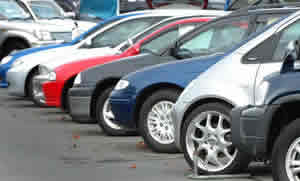Excise duty reduction spurs vehicle imports

Zimbabwe, rising from what were already high rates following the switch to hard currencies and a pent-up demand for affordable second-hand cars in reasonable condition.
The number of cars coming in through Beitbridge Border Post rose by 36 percent in January this year to 3 150 compared to the same month in 2010 as more people can afford to buy cars that still have five or more years on the road.
Zimra commissioner for legal and corporate affairs Ms Florence Jambwa confirmed the trend in a recent interview.
“The number of vehicles imported through Beitbridge Border Post has gone up significantly since January 2011 mainly due to the fact that many importers delayed the delivery of vehicles they bought last year to this year so as to benefit from the new rates of duty effective on the first of January, 2011.
“At Beitbridge Border Post, 3 150 vehicle submissions were made for the month of January 2011 compared to 2 310 vehicles imported in January 2010.
“On average, we handle about 15 car carriers per day, translating to 101 vehicles that we clear per day. There are peak periods for arrival of car carriers, especially Thursdays and Fridays and on these days we handle about 30 carriers per day translating to about 150 vehicles cleared on these days.
“Cars with an engine capacity of between 1 000 cubic cm and 1 500 cubic cm now attract excise duty of 25 percent, Value Added Tax of 15 percent and a surtax of 25 percent for vehicles that are more than five-years-old.”
A Herald survey showed that smaller numbers of vehicles come in through Kariba, Chirundu and Nyamapanda while a handful of importers use the ports of Beira and Dar es Salaam.
Most prefer Durban and Cape Town in South Africa, with the vehicles largely originating from Japan and other developed Far East countries with right-hand drive cars and systems that make it an advantage to change cars when they have less than 100 000km on the clock and are just reaching five-years-old.
Japan, with a car industry in the doldrums, has a range of incentives that make it difficult to keep a car on the road as it runs out of its guarantee, financing and service plan and makes it very easy to replace that car, even though few Japanese do more than 15 000km a year.
This means that there are a large number of Japanese cars with 50 000km to 100 000km on the clock, and which have been properly serviced under a service plan.
These cars can be bought cheaply in that country, the third largest car market in the world.
The Zimbabwean landed price is largely made up of transport charges and taxes, and the cut back in import duties has reduced that landed charge and made these cars even more affordable.
The Finance Ministry and Parliament both felt that these imports were the only way the majority of Zimbabweans were ever going to own a reasonable and reliable car and so they decided to make it easier for them to do so.
The rise in imports means the Government is now making more money than it did from car import taxes.
Mrs Jambwa said Zimra faced the challenge of cars piling up at the vehicle workstation and they were in the process of moving all clearance processes to the Manica Bonded Warehouse.
Last year, Zimra moved the clearance of all imported vehicles from the Customs yard in a bid to decongest the border post.
This was because some importers dumped their cars there after failing to pay import duties.
Mrs Jambwa said they were working towards reducing the time importers spend at border posts.
Some people spend between two and three days to get their vehicles cleared.
Although the upsurge in vehicle imports is attributed to the reduction of excise duty, it is apparently clear that the demand for second-hand vehicles in the country is very high inasmuch as Japanese used vehicles have flooded the region pulling down the prices.
Small used cars imported from Japan cost around US$5 000 locally if directly imported and around US$6 000 if bought from an importer and the mid-sized cars are only a couple of thousand dollars more expensive.
Most car buyers cannot afford to buy new imports or new locally-assembled vehicles which are fetching astronomic prices. The cheapest locally-assembled car, brand new will cost over US$20 000.
Second-hand cars from Zimbabwe and South Africa are also expensive as the owners try to claw back as much as possible of these high prices when they sell.
The decision by the Ministry of Transport, Communications and Infrastructure to ban the importation of vehicles that are over five-years-old into the country from June 30 has put extra pressure to import now, although many who hope to buy within the next year simply cannot do so at the moment and might never own a car of their own.
The increase in imports has in recent years also resulted in a burgeoning car sales business in Zimbabwe.
While many car dealerships are reputable, the courts are handling several cases in which the public has been conned by bogus importers who demand cash up front, but never deliver on their promises.
Most genuine dealers are members of trade associations, or have proper premises that are easy to find.
Many dealers sell on commission, having gone through the paper work supplied by the direct importer and made sure that all the i’s are dotted and t’s are crossed before selling the car.
While Japan is the largest single source of cars, others come from South Africa, the United Arab Emirates, Singapore, and the United Kingdom. All these countries use right-hand drive vehicles and while the ban on using left-hand drive is still more than five years off, few people want to end with a dud and most want something that is acceptable in Zimbabwe.
The Transport Ministry says it will not go back on the ban of import of second hand cars that are more than five years old.
The ban also extends to imports of cars with tinted windows and left-hand drive vehicles.
It comes into effect at the end of June this year.
The Secretary for Transport, Communications and Infrastructure Development, Mr Patson Mbriri, repeated this last week when he appeared before the House of Assembly Portfolio Committee on Transport and Communication.
“It took us a long time to have them (the regulations) gazetted within the system and we thought it worthwhile to defer the implementation. But come end of June this year we will implement them.
“What we will be prohibiting is new registration of left-hand vehicles,” he said.
While many see the point over left-hand drive vehicles where possible, if nothing else because modern headlights are designed to through their beams to the verge when dipped and a left-hand drive in Zimbabwe will thus throw the beams to the road centre, there is less understanding for the five-year ban so long as the car is still in reasonable condition.
Care buyers have noted that other countries with similar bans have far higher salaries and a sophisticated finance sector that makes it easy to obtain loans. Even in Zimbabwe had the cheap loans, few people would be able to buy new or nearly new cars since their salaries would still be too low to make the payments.











Comments